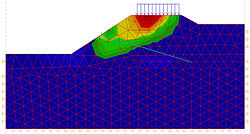Slope Stability: Difference between revisions
Rmanwaring (talk | contribs) No edit summary |
No edit summary |
||
| Line 44: | Line 44: | ||
{{Video Icon}} [[On-Demand Webinar: Strength Selection for Static Slope Stability Analysis]] | {{Video Icon}} [[On-Demand Webinar: Strength Selection for Static Slope Stability Analysis]] | ||
{{Video Icon}} [[On-Demand Webinar: Seismic Stability Evaluation of Earth Dams]] | {{Video Icon}} [[On-Demand Webinar: Seismic Stability Evaluation of Earth Dams]] | ||
{{Website Icon}} [[Technical Seminar: Stability Analysis of Embankment Dams]] | |||
<!-- For information on notation for in text citations visit https://www.mediawiki.org/wiki/Help:Cite Or simply enclose the citation as shown <ref> citation </ref> in the location of the in text mention. Citations will automatically populate below--> | <!-- For information on notation for in text citations visit https://www.mediawiki.org/wiki/Help:Cite Or simply enclose the citation as shown <ref> citation </ref> in the location of the in text mention. Citations will automatically populate below--> | ||
Revision as of 22:29, 21 February 2023

|
| Example of a slope stability analysis. (Wikipedia) |
Stability of the upstream and downstream slopes of an earth embankment dam is essential to the dam’s safe operation. Unsatisfactory slope performance includes the following categories of slope movement: shear failure, surface sloughing, excessive deformation, liquefaction, and any other types of slope movements [1]. Slope movements that do not cause an immediate failure of the dam can require significant maintenance, and if left unrepaired, can lead to an eventual failure. Proper analysis and design of the embankment slopes, coupled with close monitoring and prompt maintenance or repairs to any moved sections of the slope(s) are key to preventing failure or a major incident from occurring.
“The stability of dams and slopes must be evaluated utilizing pertinent geologic information and information regarding in situ engineering properties of soil and rock materials. The geologic information and site characteristics that should be considered include:
- "groundwater and seepage conditions;
- "lithology, stratigraphy, and geologic details disclosed by borings and geologic interpretations;
- "maximum past overburden at the site as deduced from geologic evidence;
- "structure, including bedding, folding, and faulting;
- "alteration of materials by faulting;
- "joints and joint systems;
- "weathering;
- "cementation;
- "slickensides;
- "field evidence relating to slides, earthquake activity, movement along existing faults, and tension jointing”.[1]
“Evaluation of slope stability requires: (a) establishing the conditions, called ‘design conditions’ or ‘loading conditions,’ to which the slope may be subjected during its life, and (b) performing analyses of stability for each of these conditions. There are four design conditions that must be considered for dams: (1) during and at the end of construction, (2) steady state seepage, (3) sudden drawdown, and (4) earthquake loading. The first three conditions are static; the fourth involves dynamic loading”.[1]
Examples
![]() Learn more about the need for stable slopes at earth and rockfill dams (DamFailures.org)
Learn more about the need for stable slopes at earth and rockfill dams (DamFailures.org)
Best Practices Resources
![]() Technical Release 210-60: Earth Dams and Reservoirs, NRCS, 2019
Technical Release 210-60: Earth Dams and Reservoirs, NRCS, 2019
![]() Design Standards No. 13: Embankment Dams (Ch. 4: Static Stability Analysis), USBR, 2011
Design Standards No. 13: Embankment Dams (Ch. 4: Static Stability Analysis), USBR, 2011
![]() Slope Stability (EM 1110-2-1902), USACE, 2003
Slope Stability (EM 1110-2-1902), USACE, 2003
Trainings
![]() On-Demand Webinar: Strength Selection for Static Slope Stability Analysis
On-Demand Webinar: Strength Selection for Static Slope Stability Analysis
![]() On-Demand Webinar: Seismic Stability Evaluation of Earth Dams
On-Demand Webinar: Seismic Stability Evaluation of Earth Dams
![]() Technical Seminar: Stability Analysis of Embankment Dams
Technical Seminar: Stability Analysis of Embankment Dams
Citations:
Revision ID: 6564
Revision Date: 02/21/2023
